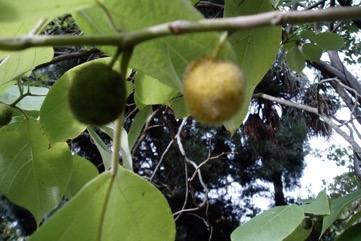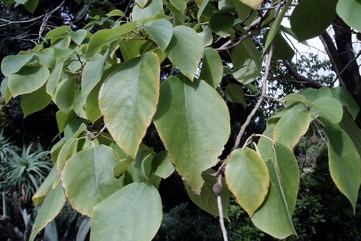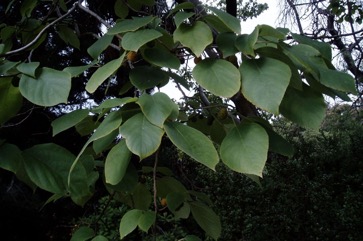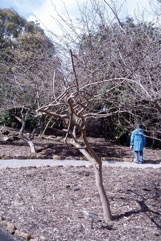Paper mulberry

A tropical plant. It is native to China and Japan. The trees are mostly planted. They are grown in many areas of PNG. They prefer a cool climate and do best on moist soils. They need good sunlight. In Yunnan in China it grows below 2000 m altitude. It suits hardiness zones 6-12. In Sichuan.
Also known as:
Ai masi, Aute, Duong, Gou shu, Goushuguo, Goutao, Gouye, Guo sha, Hiapo, Hwaing-kan-setku, Jangali toot, Kaagda, Lafi, Maisa, Mai-sai-le, Mai-sau, Maisha, Mai-tun-sao, Malaing, Malo, Mamajang, Masa, Ma san, Masi, Me day, Musa, Namas, Na sha er zi, Poh-krasah, Por sa, Rou yang, Sa lae, Tapa cloth tree, Tha-le, Tomune, Tutu, U'a, Ute, Wauke
Synonyms
- Morus papyrifera L.
- Papyrius papyrifera (L.) Kuntze
- Smithiodendron artocarpioideum Hu
- and others
Edible Portion
- Fruit, Flowers, Leaves, Seeds
Where does Paper mulberry grow?
Found in: Africa, Argentina, Asia, Australia, Britain, Cambodia, China, Easter Island, Fiji, Hawaii, Himalayas, India, Indochina, Indonesia, Japan, Korea, Laos, Madagascar, Malaysia, Marquesas, Myanmar, New Zealand, North America, Northeastern India, Pacific, Pakistan, Papua New Guinea, PNG, Philippines, Rotuma, Russia, Samoa, SE Asia, Sikkim, Slovenia, South America, Sri Lanka, Taiwan, Thailand, Tibet, Tonga, United States, Vietnam, Wallis & Futuna, Yap
Notes: Tapa cloth used by Polynesians is made from this plant. Paper is also made from it in China. There are 4-8 Broussonetia species. Chemical composition (leaves, dried): 17% calcium carbonate. It can become invasive.
Status: The tree still has some importance for Tapa cloth and rope in Papua New Guinea. It is not a major food plant.
Growing Paper mulberry
Cultivation: Trees can be grown from seeds or root suckers. Seeds are often not available. Young buds can be removed to give a straight unbranched tree. The seeds take 1-3 months to germinate at 15°C. Stem cuttings can be used.
Edible Uses: The young leaves are lightly cooked and eaten. The fleshy part of the ripe compound fruit is sweet and edible. It is eaten raw. They are added to desserts and conserves. The seeds are also edible. (The bark is also used for making cloth.) CAUTION: Eating a lot of fruit is reported to affect calcium absorption.
Production: It is fast growing.
Nutrition Info
per 100g edible portion| Edible Part | Energy (kcal) | Protein (g) | Iron (mg) | Vitamin A (ug) | Vitamin c (mg) | Zinc (mg) | % Water |
|---|---|---|---|---|---|---|---|
| Leaves | - | - | - | - | - | - | |
| Flowers | - | - | - | - | - | - | |
| Fruit | - | - | - | - | - | - | |
| Seeds | - | - | - | - | - | - |
Paper mulberry Photos




References
Polynesian mulberry references Broussonetia papyrifera
Altschul, S.V.R., 1973, Drugs and Foods from Little-known Plants. Notes in Harvard University Herbaria. Harvard Univ. Press. Massachusetts. no. 678
Ambasta S.P. (Ed.), 2000, The Useful Plants of India. CSIR India. p 87
Bajpai, O., et al, 2015, Tree species of the Himalayan Terai region of Uttar Pradesh, India: a checklist. Check List 11(4): 1718
Barwick, M., 2004, Tropical and Subtropical Trees. A Worldwide Encyclopedic Guide. Thames and Hudson p 61
Bircher, A. G. & Bircher, W. H., 2000, Encyclopedia of Fruit Trees and Edible Flowering Plants in Egypt and the Subtropics. AUC Press. p 67
Brickell, C. (Ed.), 1999, The Royal Horticultural Society A-Z Encyclopedia of Garden Plants. Convent Garden Books. p 192
Brown, Flora of Southeastern Polynesia 3 Dicotyledons p 33
Cao, Y., et al, 2020, Ethnobotanical study on wild edible plants used by three trans-boundary ethnic groups in Jiangcheng County, Pu’er, Southwest China. Journal of Ethnobiology and Ethnomedicine (2020) 16:66
Clarke, W.C. & Thaman, R.R., 1993, Agroforestry in the Pacific Islands: Systems for sustainability. United Nations University Press. New York. p 225
Coombes, A.J., 2000, Trees. Dorling Kindersley Handbooks. p 218
Cundall, P., (ed.), 2004, Gardening Australia: flora: the gardener's bible. ABC Books. p 260
Dobriyal, M. J. R. & Dobriyal, R., 2014, Non Wood Forest Produce an Option for Ethnic Food and Nutritional Security in India. Int. J. of Usuf. Mngt. 15(1):17-37
Elevitch, C.R.(ed.), 2006, Traditional Trees of the Pacific Islands: Their Culture, Environment and Use. Permanent Agriculture Resources, Holualoa, Hawaii. p 171
Etherington, K., & Imwold, D., (Eds), 2001, Botanica's Trees & Shrubs. The illustrated A-Z of over 8500 trees and shrubs. Random House, Australia. p 142
Flora of Pakistan. www.eFloras.org
Franklin, J., Keppel, G., & Whistler, W., 2008, The vegetation and flora of Lakeba, Nayau and Aiwa Islands, Central Lau Group, Fiji. Micronesica 40(1/2): 169–225, 2008
French, B.R., 1986, Food Plants of Papua New Guinea, A Compendium. Asia Pacific Science Foundation p 321
Gillaumin, R., 1954, Les Plantes utiles des Nouvelles-Hebrides (fin et complement) In: Journal d'agriculture tropicale et de botanique appliquee Vol. 1, No. 10-12 pp 453-460
Hani Medicine of Xishuangbanna, 1999, p 419
Hedrick, U.P.(ed), 1919, Sturtevant’s Edible Plants of the World p 121 (138)
Hibbert, M., 2002, The Aussie Plant Finder 2002, Florilegium. p 47
Hide, R., et al, 1979, A checklist of some plants in the territory of the Sinasina Nimai (Simbai Province, Papua New Guinea), with notes on their uses. Department Anthropology, University of Aukland
Hwang, H., et al, 2013, A Study on the Flora of 15 Islands in the Western Sea of Jeollanamdo Province, Korea. Journal of Asia-Pacific Biodiversity Vol. 6, No. 2 281-310
Jin, Chen et al, 1999, Ethnobotanical studies on Wild Edible Fruits in Southern Yunnan: Folk Names: Nutritional Value and Uses. Economic Botany 53(1) pp 2-14
Ju, Y., et al, 2013, Eating from the wild: diversity of wild edible plants used by Tibetans in Shangri-la region, Yunnan, China, Journal of Ethnobiology and Ethno medicine 9:28
Kang, Y., et al, 2012, Wild food plants and wild edible fungi in two valleys on the Qinling Mountains (Shaanxi, central China) Journal of Ethnobiology and Ethnomedicine; 9:26
Kiple, K.F. & Ornelas, K.C., (eds), 2000, The Cambridge World History of Food. CUP p 1828
Krishen P., 2006, Trees of Delhi, A Field Guide. DK Books. p 104
Kuo, W. H. J., (Ed.) Taiwan's Ethnobotanical Database (1900-2000), http://tk.agron.ntu.edu.tw/ethnobot/DB1.htm
Liefting, A., et al, Samoan plant names. http://en.wikipedia.org
Little, E.L., 1980, National Audubon Society Field Guide to North American Trees. Alfred A. Knopf. p 429
Luo, B., et al, 2019, Wild edible plants collected by Hani from terraced rice paddy agroecosystem in Honghe Prefecture, Yunnan, China. Journal of Ethnobiology and Ethnomedicine 15:56
Lyle, S., 2006, Discovering fruit and nuts. Land Links. p 95
Makino,
Marinelli, J. (Ed), 2004, Plant. DK. p 446
Martin, F.W. & Ruberte, R.M., 1979, Edible Leaves of the Tropics. Antillian College Press, Mayaguez, Puerto Rico. p 205
Mot So Rau Dai an Duoc O Vietnam. Wild edible Vegetables. Ha Noi 1994, p 175
Mozhui, R., et al, 2011, Wild edible fruits used by the tribals of Dimapur district of Nagaland, India. Pleione 5(1): 56 - 64.
Neal, C.M., 1965, In Gardens of Hawaii, Bishop Museum Press. p
Peekel, P.G., 1984, (Translation E.E.Henty), Flora of the Bismarck Archipelago for Naturalists, Division of Botany, Lae, PNG. p 131, 133
Plants for a Future database, The Field, Penpol, Lostwithiel, Cornwall, PL22 0NG, UK. http://www.scs.leeds.ac.uk/pfaf/
Plants of Papua New Guinea LAE herbarium record
Purseglove, J.W., 1968, Tropical Crops:Dicotyledons, Longmans. p 377
READ
Recher, P, 2001, Fruit Spirit Botanical Gardens Plant Index. www.nrg.com.au/~recher/ seedlist.html p 5
Smith, A.C., 1981, Flora Vitiensis Nova, Lawaii, Kuai, Hawaii, Volume 2 p 203
Staples, G.W. and Herbst, D.R., 2005, A tropical Garden Flora. Bishop Museum Press, Honolulu, Hawaii. p 404 (Drawing)
Tabl. regn. veg. 3:547. 1799
Tanaka, T., 1976, Tanaka’s Cyclopedia of Edible Plants of the World. Keigaku. p 108
Terra, G.J.A., 1973, Tropical Vegetables. Communication 54e Royal Tropical Institute, Amsterdam, p 33
Valder, P., 1999, The Garden Plants of China. Florilegium. p 267
Van Sam, H. et al, 2004, Trees of Laos and Vietnam: A Field Guide to 100 Economically or Ecologically Important Species. Blumea 29 (2004) 201-349
Wang, J. et al, 2013, A Study on the Utilization of Wild Plants for Food in Liangshan Yi Autonomous Prefecture. Plant Diversity and Resources. 35(4): 416-471
Wealth of India p 230
World Checklist of Useful Plant Species 2020. Royal Botanic Gardens, Kew
www.eFloras.org Flora of China
www.worldagroforestrycentre.org/treedb/
Xu, You-Kai, et al, 2004, Wild Vegetable Resources and Market Survey in Xishuangbanna, Southwest China. Economic Botany. 58(4): 647-667.
Yuncker, T.G., 1959, Plants of Tonga, Bernice P. Bishop Museum, Hawaii, Bulletin 220. p 97
Zizka, G., 1991, Flowering Plants of Easter Island. Palmarum Hortus Francofurtensis